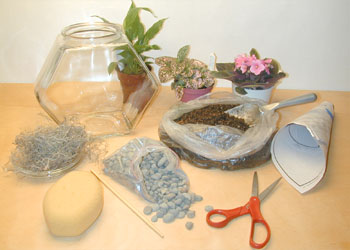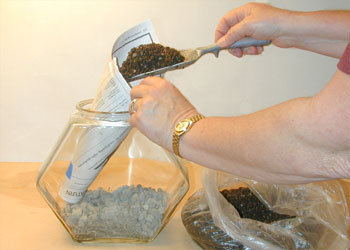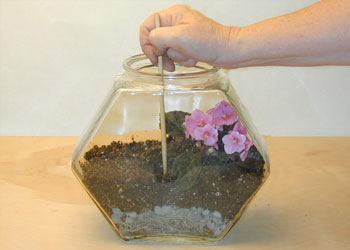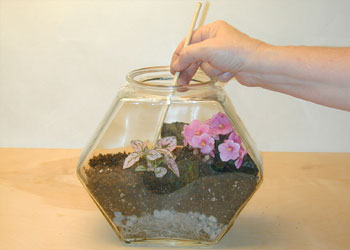Indoor Plants
Terrariums/สวนจิ๋ว





"Terra" is the Latin word for "earth," as in the ground, or soil. "Arium" is a Latin suffix (end of a word) which means "enclosure for safe-keeping." So, a terrarium must be an enclosure with soil, for the safe-keeping of something that needs soil. What is the first thing that comes to mind when we wonder what needs soil? Plants.
A terrarium is a transparent glass or plastic container with soil. It has an open or closed top and is used for displaying growing plants as a miniature landscape. Many kinds of containers can be adapted for terrariums. These clear-sided containers have no drain holes and usually have a clear top. When a terrarium is properly planted and located, it can be a source of enjoyment for years, providing an interesting way to grow and display many plants with relatively little care.
CONTAINERS
Almost any type of clear glass or plastic container can be used for a terrarium: fish bowl, fish tank, glass jar, jug or bottle. There are containers made especially for terrariums. The container must be clear, however, as tinted or cloudy glass reduces light and interferes with plant growth.
Containers can be closed or open. Plants in closed containers must be tolerant of high humidity. Containers with large openings without covers may be used but will require more frequent watering to maintain humidity. An open container with plants that do not require high humidity works well with less frequent watering. Open terrariums are drier and less subject to diseases.
PLANTS/พันธุ์ไม้
กลุ่มไม้ที่ชอบแสงรำไร หรือไม้ในร่ม เช่น
1. กวนอิม
2. ก้ามปูหลุด
3. คล้า
4. ซุ้มกระต่ายด่าง
5. ซิงโกเนียม (Syngonium)
6. บอนสี
7. sandherbs.cscoms.com/flower/content/f89.shtml">บีโกเนีย
8. ปีกแมลงสาบ
9. เปเปอโรเมีย/Peperomia
10. พรมกำมะหยี่หรือพรมญี่ปุ่น
11. พรมออสเตรเลีย
12. พลูต่างๆ และฟิโลเดนดรอน บางชนิด
13.ละอองดาว
14. ลิ้นมังกร
15. เศรษฐีเรือนในและเศรษฐีเรือนนอก
16. สายรุ้ง
17. หนวดปลาดุกแคระ
18. หูเสือ
19. หมากผู้หมากเมีย
20. อโลคาเซีย
21. แอฟริกันไวโอเลต
22. ไอวี่
23. พืชอิงอาศัย
23.1 กล้วยไม้
23.2 โฮย่า
23.3 เดปต่างๆ
23.4 สับปะรดสี
24. ไม้หัว
กลุ่มไม้อวบน้ำ
เช่น แคคตัส ซัคคิวเลนท์ต่างๆ
กลุ่มไม้น้ำ
เช่น กกต่างๆ ผักแว่น แว่นแก้ว อเมซอนใบกลม สาหร่าย บัว บัวบา กระจับแก้ว ดอกจอก จอกหนูหนู ลานไพลิน ฝิ่นน้ำ สาหร่ายญี่ปุ่น
Many plants are suitable for growing in terrariums. Low-growing, dense plants are best. Large plants can be used and kept small by pruning. Choose plants for variations in size, texture and color, as well as their adaptability.
Determine the location for the terrarium. Note the light conditions and temperature of this area. Select plants that suit the location and have similar requirements. Do not combine a plant that prefers low light with one that needs high light. At least one of the plants will perform poorly because its basic needs are not being met.
Most plants require light near a window or supplemental artificial light. The terrarium should be located within several feet of a bright window but not in direct sun.
SOIL
Soil must be high in organic matter, clean and well-drained. Most potting soils sold at nurseries and garden centers have been sterilized. Since plants are not meant to grow rapidly, adding fertilizer is not necessary.
It is possible to make your own mix by combining by volume one part peat and one part soil conditioning grade of pine bark with one part rich garden soil. The soil in the mix must be sterilized by heating it to an internal temperature of 200 ฐF. This causes an unpleasant odor.
PLANTING THE TERRARIUM
Sterilize the container before planting. Wash in hot, soapy water and rinse thoroughly, run it through the dishwasher, or wash with a 1:15 bleach/water solution then rinse with water. If you use a commercial glass cleaner, allow the open container to air for several days before planting.
If your container does not have an obvious front or back, select one to use as the "back" side. Determine the arrangement of the plants by either moving them around inside the container (if it has a large opening) or in an open area about the size of the container. Plants should be arranged so that taller plants are toward the back. A low, coarse-textured plant makes a dominant focal point near the front. Use sand, rocks, shells, wood and other natural materials for visual interest. If the terrarium is to be viewed from all directions, the display should have a hill in the middle.
In general, about a quarter of the container will be used for drainage material and soil. Place a layer of pea gravel or aquarium gravel in the bottom of the container for drainage. Next, place a ฝ-inch layer of horticultural charcoal above the pebbles to keep the soil from developing a sour smell. Sphagnum moss may be placed over the charcoal to prevent soil from sifting into the drainage area.
Add relatively dry soil to the container (it should not be so wet that it sticks to the side). For most containers, a minimum thickness of 1ฝ inches is needed. To add interest you may choose to arrange the soil so that it slopes from the back of the container towards the front.
A large kitchen spoon is helpful in placing drainage material and soil in the container. If the container has a very small opening, a paper or aluminum foil funnel will help, as will an iced tea spoon taped to a bamboo stick.
It is very important when planting a terrarium that all plants be insect- and disease-free. Remove any leaves that are yellowed, damaged or show any sign of disease or insect damage. Trim the roots of any plants that have a circling rootball.
Rocks and wood should be added to the container after the soil. Then place the plants in the container. When planting in a container with a wide opening, use a spoon to scoop out the potting holes. Place each plant so the top of the rootball is level with the top of the soil. It should sit in the soil in the container no lower and no higher than it did in the pot.
When placing plants in a deep container, or one with a small opening, use long, slender tongs or a stick with a wire loop on the end. Dig holes with a pointed stick before inserting the plants. After the plant has been placed in the hole, fill in with soil and firm gently. A good tool for firming the soil is a long stick with a cork fixed on the end. Add moss and other accessories lastly to give a finished appearance.
After planting, mist to clean soil sticking to the leaves or the sides of the container. The water from the mist should be sufficient to settle the soil and provide moisture. No heavy watering is necessary at this time. Mist again the next day, observing the water level at the bottom, which should not exceed a quarter inch. Keep the container uncovered until the leaves are completely dry. If the terrarium is the closed type, apply the cover at this time.
Remove any plant that begins to rot. Rot is often associated with too much moisture. If this occurs in a closed container, remove the cover to allow more drying. Generally, after a few weeks, the terrarium is established and the threat of disease is reduced. Continue to watch for falling leaves or any plant parts that begin to decay.
CARE AFTER PLANTING
The closed terrarium probably will not need to be watered for four to six months. Do not replace the cover until the leaves have dried somewhat. Open terrariums need occasional watering, but not as often as other houseplants. Waterings should always be light. Heavy waterings result in too much standing water. It is better to be a little too dry than too wet.
Many plants outgrow their neighbors or the terrarium. With a little trimming these plants can be brought into bounds. Frequently pinching out tips before a plant becomes too tall will result in more balanced growth than infrequent, more severe cutbacks.
Do not plan to fertilize for at least a year after planting. If the plants are yellowish and lack vigor without any apparent reason, fertilize very lightly with a water-soluble houseplant fertilizer at about one-tenth the rate recommended for normal houseplants.
Occasionally it may be necessary to replace plants. Follow the same directions and precautions for adding new plants to the terrarium.
Some foliage plants that do well in a small-mouthed terrarium include creeping fig (Ficus pumila), Ti plant (Cordyline terminalis), ribbon plant (Dracaena sanderiana), earth star (Cryptanthus acaulis), prayer plants (Maranta species) and parlor palm (Chamaedorea elegans). Do not use ferns they will take over a terrarium.
Indoor Plants - Terrariums
| Create Date : 15 สิงหาคม 2548 |
| Last Update : 8 มกราคม 2549 19:15:19 น. |
|
11 comments
|
| Counter : 3480 Pageviews. |
 |
|
|



ถ้ามีเวลา มีอุปกรณ์ก็อยากทำเหมือนกันค่ะ